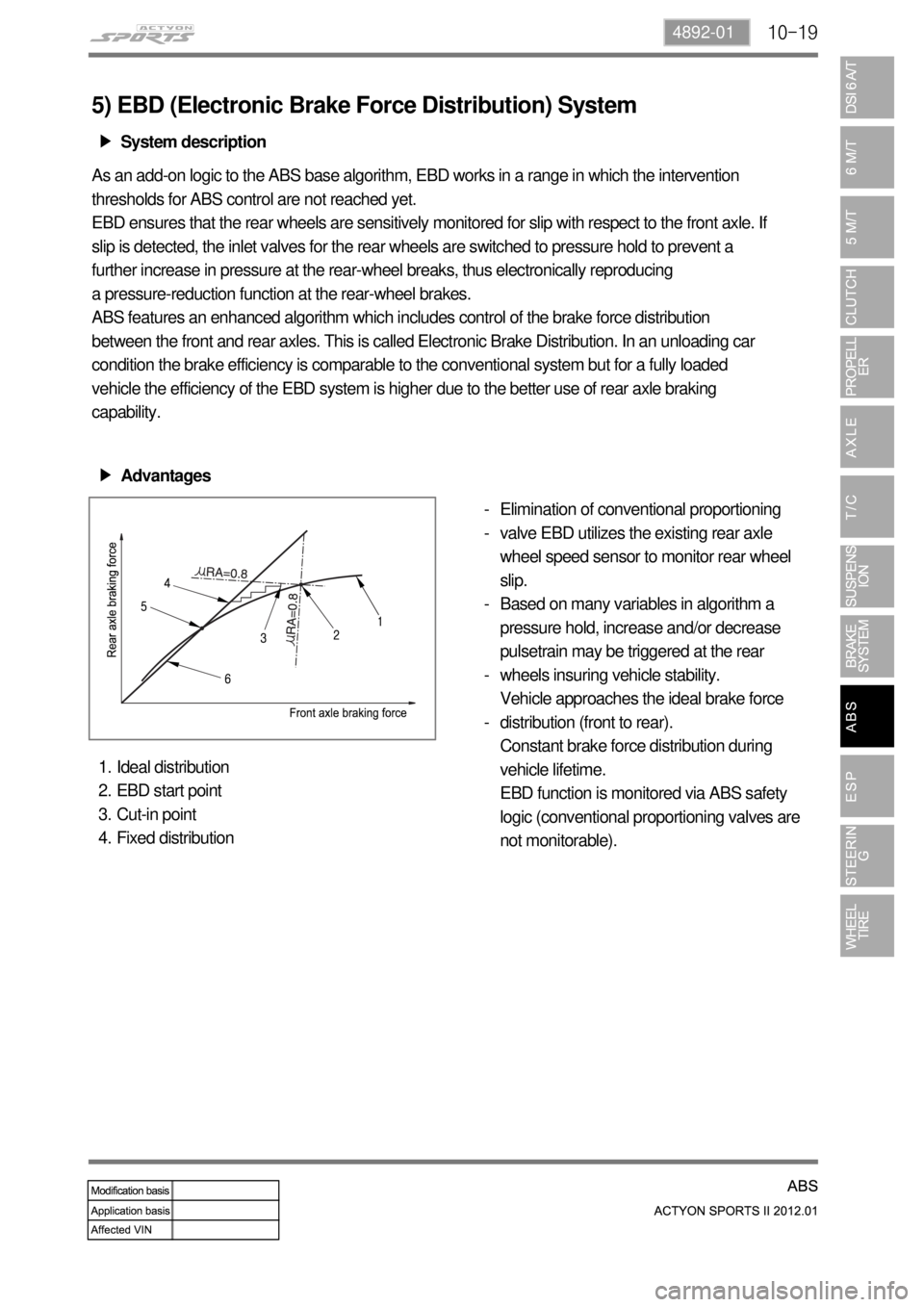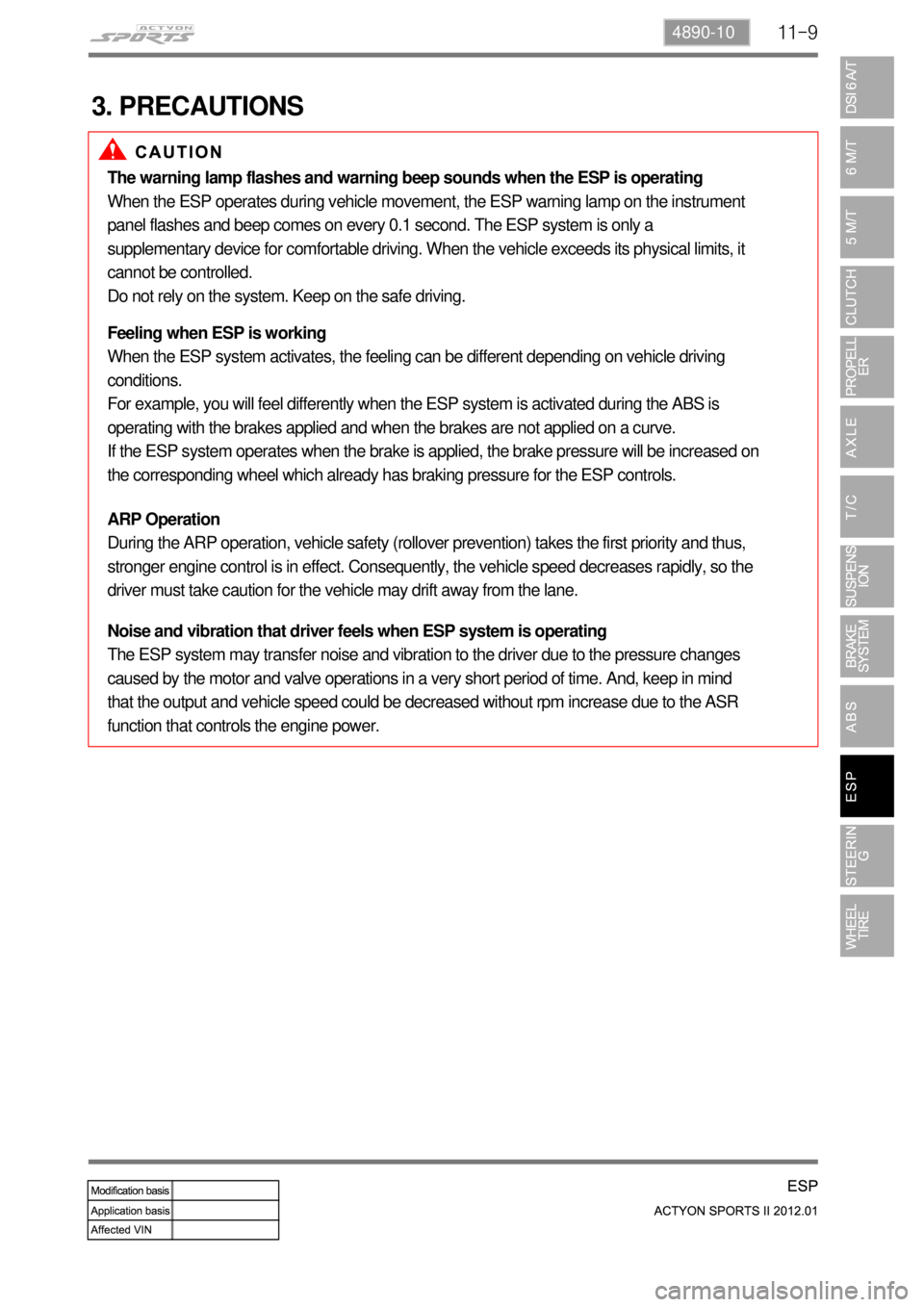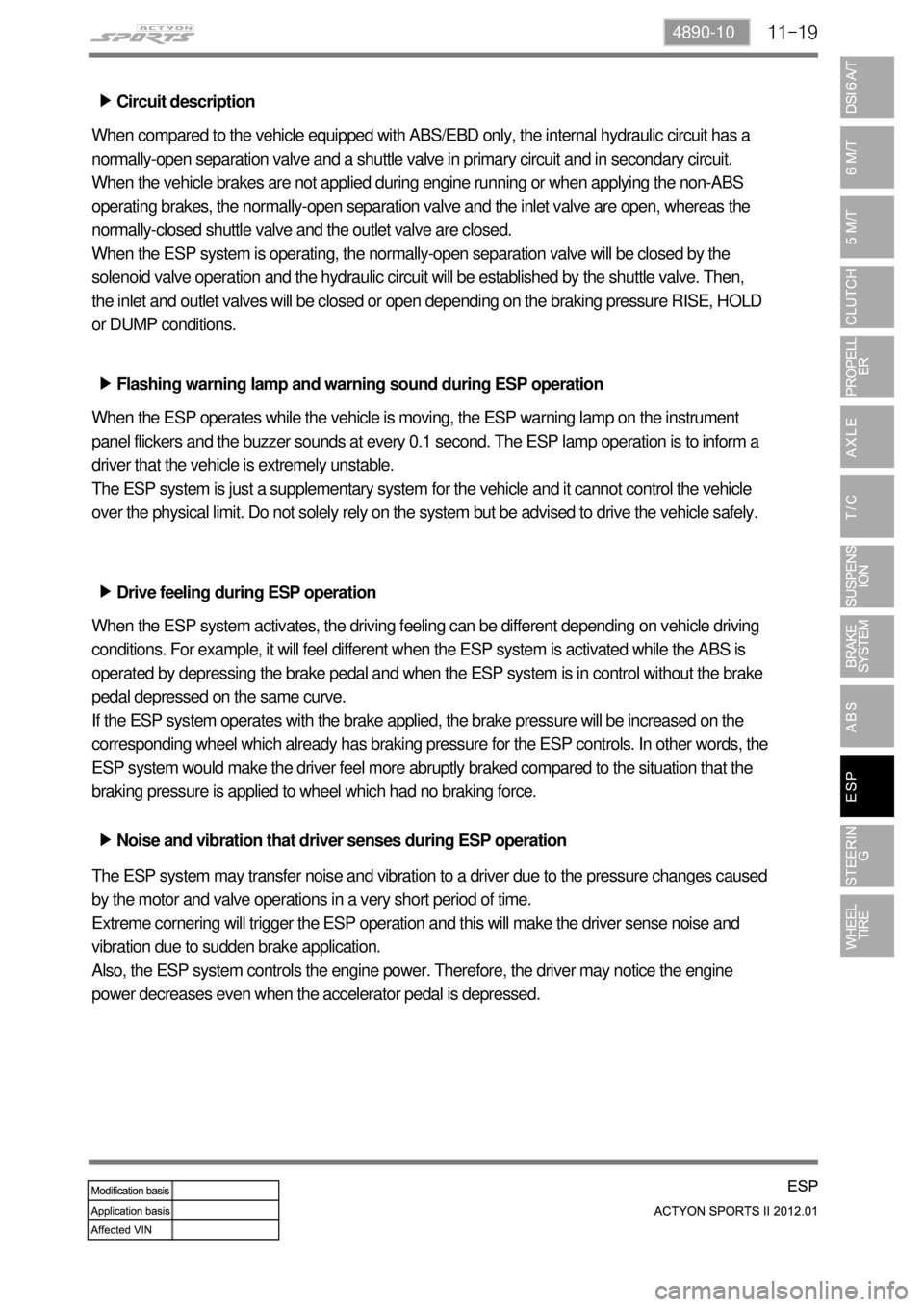2012 SSANGYONG NEW ACTYON SPORTS brakes
[x] Cancel search: brakesPage 652 of 828

09-4
2. SYSTEM OVERVIEW
1) Terms and Definition
CBS: Conventional Brake System
ABS: Anti-Lock Brake System
EBD: Electronic brake-Force Distribution
ESP: Electronic Stability Program
ABD: Automatic Braking Differential
ASR: Acceleration Slip Regulation
AYC: Active Yaw Control (Understeer and Oversteer Control)
HBA: Hydraulic Brake Assistant
ARP: Active Rollover Protection
HSA: Hill Start Assistant
Brake pad: Brake pad is a component of disk brakes used in automotive and other
applications. Brake pad is steel backing plates with friction material bound to the surface that
faces the brake disc.
Brake disc: The brake disc is a device for slowing or stopping the rotation of a wheel while it is
in motion.
Brake caliper: To stop the wheel, friction material in the form of brake pads (mounted on a
device called a brake caliper) is forced hydraulically against both sides of the disc. Friction
causes the disc and attached wheel to slow or stop.
Brake master cylinder: The brake master cylinder is a control device that converts non-
hydraulic pressure (commonly from a driver's foot) into hydraulic pressure, in order to move
other device(s) which are located at the other end of the hydraulic system, such as one or
more slave cylinders. As piston(s) move along the bore of the master cylinder, this movement
is transferred through the hydraulic fluid, to result in a movement of the slave cylinder(s). The
hydraulic pressure created by moving a piston (inside the bore of the master cylinder) toward
the slave cylinder(s) compresses the fluid evenly, but by varying the comparative surface-area
of the master cylinder and/or each slave cylinder, one will vary the amount of force and
displacement applied to each slave cylinder (relative to the amount of force and displacement
that was applied to the master cylinder). -
-
-
-
-
-
-
-
-
-
-
-
-
-
FunctionVehicle with CBS
Vehicle with ABS/EBD Vehicle with ESP
ABS
Not appliedApplied
Applied EBD Applied
ABD
Not applied ASR
AYC
HBA
ARP
2) Functions
Page 685 of 828

10-6
1. SYSTEM OVERVIEW
1) What is ABS?
When braking suddenly or braking on slippery roads, the vehicle keeps moving forward but the
wheels are locking and not rotating. If these happen, the vehicle may lose stability or rotate
resulting in an accident. ABS helps to maintain directional stability and control of the vehicle. ABS
is designed to secure more safety and increase the control of steering wheel during emergency
braking situation. But, ABS does not guarantee perfect safety beyond its physical limit. ABS in
this vehicle contains EBD function. In normal driving conditions, the brake system operates
without ABS function.
2) What is EBD (Electronic Brake-force Distribution)?
EBD is an automobile brake technology that automatically varies the amount of force applied to
each of a vehicle's brakes, based on road conditions, speed, loading, etc. Always coupled with
anti-lock braking systems, EBD can apply more or less braking pressure to each wheel in order to
maximize stopping power whilst maintaining vehicular control. EBD does not operate when ABS is
working.
ABS effect according to braking conditions ▶
Braking on split road Maneuvering while braking
Page 698 of 828

10-194892-01
5) EBD (Electronic Brake Force Distribution) System
System description ▶
As an add-on logic to the ABS base algorithm, EBD works in a range in which the intervention
thresholds for ABS control are not reached yet.
EBD ensures that the rear wheels are sensitively monitored for slip with respect to the front axle. If
slip is detected, the inlet valves for the rear wheels are switched to pressure hold to prevent a
further increase in pressure at the rear-wheel breaks, thus electronically reproducing
a pressure-reduction function at the rear-wheel brakes.
ABS features an enhanced algorithm which includes control of the brake force distribution
between the front and rear axles. This is called Electronic Brake Distribution. In an unloading car
condition the brake efficiency is comparable to the conventional system but for a fully loaded
vehicle the efficiency of the EBD system is higher due to the better use of rear axle braking
capability.
Advantages ▶
Elimination of conventional proportioning
valve EBD utilizes the existing rear axle
wheel speed sensor to monitor rear wheel
slip.
Based on many variables in algorithm a
pressure hold, increase and/or decrease
pulsetrain may be triggered at the rear
wheels insuring vehicle stability.
Vehicle approaches the ideal brake force
distribution (front to rear).
Constant brake force distribution during
vehicle lifetime.
EBD function is monitored via ABS safety
logic (conventional proportioning valves are
not monitorable). -
-
-
-
-
Ideal distribution
EBD start point
Cut-in point
Fixed distribution 1.
2.
3.
4.
Page 710 of 828

11-94890-10
3. PRECAUTIONS
The warning lamp flashes and warning beep sounds when the ESP is operating
When the ESP operates during vehicle movement, the ESP warning lamp on the instrument
panel flashes and beep comes on every 0.1 second. The ESP system is only a
supplementary device for comfortable driving. When the vehicle exceeds its physical limits, it
cannot be controlled.
Do not rely on the system. Keep on the safe driving.
Feeling when ESP is working
When the ESP system activates, the feeling can be different depending on vehicle driving
conditions.
For example, you will feel differently when the ESP system is activated during the ABS is
operating with the brakes applied and when the brakes are not applied on a curve.
If the ESP system operates when the brake is applied, the brake pressure will be increased on
the corresponding wheel which already has braking pressure for the ESP controls.
ARP Operation
During the ARP operation, vehicle safety (rollover prevention) takes the first priority and thus,
stronger engine control is in effect. Consequently, the vehicle speed decreases rapidly, so the
driver must take caution for the vehicle may drift away from the lane.
Noise and vibration that driver feels when ESP system is operating
The ESP system may transfer noise and vibration to the driver due to the pressure changes
caused by the motor and valve operations in a very short period of time. And, keep in mind
that the output and vehicle speed could be decreased without rpm increase due to the ASR
function that controls the engine power.
Page 718 of 828

11-174890-10
5) ARP (Active Roll-Over Protection
The ARP (Active Roll-over Protection) system is a safety assistant device that minimizes, by
controlling brakes and the engine, the physical tendency of the vehicle rollover during sharp lane
changes or U-turns. For the system, software is added to the existing ESP system and no
additional device or switch is needed. One must note that the ARP system, just as general
assistant devices including the ABS, is only a safety assistant device using the ESP system and its
function is useless when the situation overcomes the physical power. Following picture shows
how the ARP compensates the vehicle position by varying each wheel's braking power to
overcome the physical tendency of the vehicle rollover during sharp turns.
Lateral sensor
(In sensor cluster)
Vehicle speedBrake force
Radius
The vehicle driving condition is controlled by the internally programmed logic according to the
input signals from wheel speed sensor, steering angle sensor and lateral sensor.
During the ARP operation, vehicle safety (rollover prevention) takes the first priority and thus,
stronger engine control is in effect. Consequently, the vehicle speed decreases rapidly, so the
driver must take caution for the vehicle may drift away from the lane.
Page 720 of 828

11-194890-10
Circuit description ▶
When compared to the vehicle equipped with ABS/EBD only, the internal hydraulic circuit has a
normally-open separation valve and a shuttle valve in primary circuit and in secondary circuit.
When the vehicle brakes are not applied during engine running or when applying the non-ABS
operating brakes, the normally-open separation valve and the inlet valve are open, whereas the
normally-closed shuttle valve and the outlet valve are closed.
When the ESP system is operating, the normally-open separation valve will be closed by the
solenoid valve operation and the hydraulic circuit will be established by the shuttle valve. Then,
the inlet and outlet valves will be closed or open depending on the braking pressure RISE, HOLD
or DUMP conditions.
Flashing warning lamp and warning sound during ESP operation ▶
When the ESP operates while the vehicle is moving, the ESP warning lamp on the instrument
panel flickers and the buzzer sounds at every 0.1 second. The ESP lamp operation is to inform a
driver that the vehicle is extremely unstable.
The ESP system is just a supplementary system for the vehicle and it cannot control the vehicle
over the physical limit. Do not solely rely on the system but be advised to drive the vehicle safely.
Drive feeling during ESP operation ▶
When the ESP system activates, the driving feeling can be different depending on vehicle driving
conditions. For example, it will feel different when the ESP system is activated while the ABS is
operated by depressing the brake pedal and when the ESP system is in control without the brake
pedal depressed on the same curve.
If the ESP system operates with the brake applied, the brake pressure will be increased on the
corresponding wheel which already has braking pressure for the ESP controls. In other words, the
ESP system would make the driver feel more abruptly braked compared to the situation that the
braking pressure is applied to wheel which had no braking force.
Noise and vibration that driver senses during ESP operation ▶
The ESP system may transfer noise and vibration to a driver due to the pressure changes caused
by the motor and valve operations in a very short period of time.
Extreme cornering will trigger the ESP operation and this will make the driver sense noise and
vibration due to sudden brake application.
Also, the ESP system controls the engine power. Therefore, the driver may notice the engine
power decreases even when the accelerator pedal is depressed.